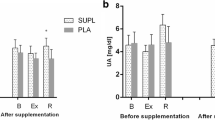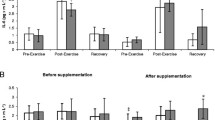Abstract
The aim of the study was to determine the effects of an antioxidant supplementation, which includes coenzyme Q10, on plasma and neutrophil oxidative stress and the antioxidant response after a soccer match. Nineteen voluntary male pre-professional footballers were randomly and double-blinded treated with either a multivitamin and mineral supplement (n = 8) or a placebo (n = 11). After the 3 months of supplementation, the sportsmen played a friendly soccer match of 60 min. The 3-month supplementation induced higher plasma ascorbate and coenzyme Q levels when compared to the placebo group. Antioxidant supplementation influenced plasma oxidative stress markers because they were lower in the supplemented group than in the placebo one after the match. The football match induced decreased neutrophil vitamin E levels and catalase and glutathione peroxidase activities but increased glutathione reductase activity. Antioxidant diet supplementation prevented plasma oxidative damage but did not influence the neutrophil response to a football match.


Similar content being viewed by others
References
Aebi HE (1984) Catalase. In: Bergmeyer HU (ed) Methods in enzymatic analysis. Verlag Chemie, Basel, pp 273–286
Aguilo A, Tauler P, Fuentespina E, Tur JA, Cordova A, Pons A (2005) Antioxidant response to oxidative stress induced by exhaustive exercise. Physiol Behav 84:1–7. doi:10.1016/j.physbeh.2004.07.034
Alleva R, Tomasetti M, Bompadre S, Littarru GP (1997) Oxidation of LDL and their subfractions: kinetic aspects and CoQ10 content. Mol Aspects Med 18(Suppl):S105–S112. doi:10.1016/S0098-2997(97)00039-3
Arts FJ, Kuipers H (1994) The relation between power output, oxygen uptake and heart rate in male athletes. Int J Sports Med 15:228–231
Balsom PD, Seger J, Sjodin B, Ekblom B (1992) Physiological response to maximal intensity intermittent exercise. Eur J Appl Physiol Occup Physiol 65:144–149. doi:10.1007/BF00705072
Bhagavan HN, Chopra RK (2006) Coenzyme Q10: absorption, tissue uptake, metabolism and pharmacokinetics. Free Radic Res 40:445–453. doi:10.1080/10715760600617843
Boyum A (1964) Separation of white blood cells. Nature 204:793–794. doi:10.1038/204793a0
Cannon J, Blumberg JB (2000) Acute phase immune response in exercise. In: Sen CK, Packer L, Hänninen O (eds) Handbook of oxidants and antioxidants in exercise. Elsevier , Amsterdam, pp 177–194
Cases N, Aguilo A, Tauler P, Sureda A, Llompart I, Pons A et al (2005) Differential response of plasma and immune cell’s vitamin E levels to physical activity and antioxidant vitamin supplementation. Eur J Clin Nutr 59:781–788. doi:10.1038/sj.ejcn.1602143
Cases N, Sureda A, Maestre I, Tauler P, Aguilo A, Cordova A et al (2006) Response of antioxidant defences to oxidative stress induced by prolonged exercise: antioxidant enzyme gene expression in lymphocytes. Eur J Appl Physiol 98:263–269. doi:10.1007/s00421-006-0273-y
Crane FL (2001) Biochemical functions of coenzyme Q10. J Am Coll Nutr 20:591–598
Ernster L, Forsmark-Andree P (1993) Ubiquinol: an endogenous antioxidant in aerobic organisms. Clin Investig 71:S60–S65. doi:10.1007/BF00226842
Flohe L, Gunzler WA (1984) Assays of glutathione peroxidase. Methods Enzymol 105:114–121. doi:10.1016/S0076-6879(84)05015-1
Goldberg DM, Spooner RJ (1985) Glutathione reductase. In: Bergmeyer HU (ed) Methods in enzymatic analysis. Verlag Chemie, Basel, pp 258–265
Gomez-Cabrera MC, Borras C, Pallardo FV, Sastre J, Ji LL, Vina J (2005) Decreasing xanthine oxidase-mediated oxidative stress prevents useful cellular adaptations to exercise in rats. J Physiol 567:113–120. doi:10.1113/jphysiol.2004.080564
Jackson MJ (1999) Free radicals in skin and muscle: damaging agents or signals for adaptation? Proc Nutr Soc 58:673–676. doi:10.1017/S0029665199001317
Kagan T, Davis C, Lin L, Zakeri Z (1999) Coenzyme Q10 can in some circumstances block apoptosis, and this effect is mediated through mitochondria. Ann NY Acad Sci 887:31–47
Kaikkonen J, Tuomainen TP, Nyyssonen K, Salonen JT (2002) Coenzyme Q10: absorption, antioxidative properties, determinants, and plasma levels. Free Radic Res 36:389–397. doi:10.1080/10715760290021234
Karvonen J, Vuorimaa T (1988) Heart rate and exercise intensity during sport activities. Practical application. Sports Med 5:303–311. doi:10.2165/00007256-198805050-00002
Krause R, Patruta S, Daxbock F, Fladerer P, Biegelmayer C, Wenisch C (2001) Effect of vitamin C on neutrophil function after high-intensity exercise. Eur J Clin Invest 31:258–263. doi:10.1046/j.1365-2362.2001.00797.x
Langsjoen PH, Langsjoen AM (1999) Overview of the use of CoQ10 in cardiovascular disease. Biofactors 9:273–284
Lass A, Sohal RS (2000) Effect of coenzyme Q(10) and alpha-tocopherol content of mitochondria on the production of superoxide anion radicals. FASEB J 14:87–94
Levine RL, Williams JA, Stadtman ER, Shacter E (1994) Carbonyl assays for determination of oxidatively modified proteins. Methods Enzymol 233:346–357. doi:10.1016/S0076-6879(94)33040-9
McArdle F, Pattwell DM, Vasilaki A, McArdle A, Jackson MJ (2005) Intracellular generation of reactive oxygen species by contracting skeletal muscle cells. Free Radic Biol Med 39:651–657. doi:10.1016/j.freeradbiomed.2005.04.010
McCord JM, Fridovich I (1969) Superoxide dismutase. An enzymic function for erythrocuprein (hemocuprein). J Biol Chem 244:6049–6055
Miyazaki H, Oh-ishi S, Ookawara T, Kizaki T, Toshinai K, Ha S et al (2001) Strenuous endurance training in humans reduces oxidative stress following exhausting exercise. Eur J Appl Physiol 84:1–6. doi:10.1007/s004210000342
Morante M, Sandoval J, Gomez-Cabrera MC, Rodriguez JL, Pallardo FV, Vina JR et al (2005) Vitamin E deficiency induces liver nuclear factor-kappaB DNA-binding activity and changes in related genes. Free Radic Res 39:1127–1138. doi:10.1080/10715760500193820
Nieman DC (1994) Exercise, upper respiratory tract infection, and the immune system. Med Sci Sports Exerc 26:128–139. doi:10.1249/00005768-199402000-00002
Niklowitz P, Menke T, Andler W, Okun JG (2004) Simultaneous analysis of coenzyme Q10 in plasma, erythrocytes and platelets: comparison of the antioxidant level in blood cells and their environment in healthy children and after oral supplementation in adults. Clin Chim Acta 342:219–226. doi:10.1016/j.cccn.2003.12.020
Ohno H, Yahata T, Sato Y, Yamamura K, Taniguchi N (1988) Physical training and fasting erythrocyte activities of free radical scavenging enzyme systems in sedentary men. Eur J Appl Physiol Occup Physiol 57:173–176. doi:10.1007/BF00640658
Overvad K, Diamant B, Holm L, Holmer G, Mortensen SA, Stender S (1999) Coenzyme Q10 in health and disease. Eur J Clin Nutr 53:764–770. doi:10.1038/sj.ejcn.1600880
Petersen EW, Ostrowski K, Ibfelt T, Richelle M, Offord E, Halkjaer-Kristensen J et al (2001) Effect of vitamin supplementation on cytokine response and on muscle damage after strenuous exercise. Am J Physiol Cell Physiol 280:C1570–C1575
Podda M, Weber C, Traber MG, Milbradt R, Packer L (1999) Sensitive high-performance liquid chromatography techniques for simultaneous determination of tocopherols, tocotrienols, ubiquinols and ubiquinones in biological samples. In: Packer L (ed) Methods in enzymology. Oxidants and antioxidants. Academic Press, San Diego, pp 330–341
Radak Z, Kaneko T, Tahara S, Nakamoto H, Ohno H, Sasvari M et al (1999) The effect of exercise training on oxidative damage of lipids, proteins, and DNA in rat skeletal muscle: evidence for beneficial outcomes. Free Radic Biol Med 27:69–74. doi:10.1016/S0891-5849(99)00038-6
Radak Z, Sasvari M, Nyakas C, Pucsok J, Nakamoto H, Goto S (2000) Exercise preconditioning against hydrogen peroxide-induced oxidative damage in proteins of rat myocardium. Arch Biochem Biophys 376:248–251. doi:10.1006/abbi.2000.1719
Radak Z, Ogonovszky H, Dubecz J, Pavlik G, Sasvari M, Pucsok J et al (2003) Super-marathon race increases serum and urinary nitrotyrosine and carbonyl levels. Eur J Clin Invest 33:726–730. doi:10.1046/j.1365-2362.2003.01202.x
Reid MB (2001) Invited review: redox modulation of skeletal muscle contraction: what we know and what we don’t. J Appl Physiol 90:724–731. doi:10.1063/1.1381002
Sastre J, Asensi M, Gasco E, Pallardo FV, Ferrero JA, Furukawa T et al (1992) Exhaustive physical exercise causes oxidation of glutathione status in blood: prevention by antioxidant administration. Am J Physiol 263:R992–R995
Schroder H, Navarro E, Tramullas A, Mora J, Galiano D (2000) Nutrition antioxidant status and oxidative stress in professional basketball players: effects of a three compound antioxidative supplement. Int J Sports Med 21:146–150. doi:10.1055/s-2000-8870
Sureda A, Tauler P, Aguilo A, Cases N, Fuentespina E, Cordova A et al (2005) Relation between oxidative stress markers and antioxidant endogenous defences during exhaustive exercise. Free Radic Res 39:1317–1324. doi:10.1080/10715760500177500
Suzuki K, Totsuka M, Nakaji S, Yamada M, Kudoh S, Liu Q et al (1999) Endurance exercise causes interaction among stress hormones, cytokines, neutrophil dynamics, and muscle damage. J Appl Physiol 87:1360–1367
Tauler P, Aguilo A, Cases N, Sureda A, Gimenez F, Villa G et al (2002a) Acute phase immune response to exercise coexists with decreased neutrophil antioxidant enzyme defences. Free Radic Res 36:1101–1107. doi:10.1080/1071576021000028334
Tauler P, Aguilo A, Fuentespina E, Tur JA, Pons A (2002b) Diet supplementation with vitamin E, vitamin C and beta-carotene cocktail enhances basal neutrophil antioxidant enzymes in athletes. Pflugers Arch 443:791–797. doi:10.1007/s00424-001-0770-0
Tauler P, Aguilo A, Gimeno I, Fuentespina E, Tur JA, Pons A (2003a) Influence of vitamin C diet supplementation on endogenous antioxidant defences during exhaustive exercise. Pflugers Arch 446:658–664. doi:10.1007/s00424-003-1112-1
Tauler P, Aguilo A, Gimeno I, Noguera A, Agusti A, Tur JA et al (2003b) Differential response of lymphocytes and neutrophils to high intensity physical activity and to vitamin C diet supplementation. Free Radic Res 37:931–938. doi:10.1080/1071576031000150454
Tauler P, Sureda A, Cases N, Aguilo A, Rodriguez-Marroyo JA, Villa G et al (2006) Increased lymphocyte antioxidant defences in response to exhaustive exercise do not prevent oxidative damage. J Nutr Biochem 17:665–671. doi:10.1016/j.jnutbio.2005.10.013
Thomas SR, Neuzil J, Stocker R (1996) Cosupplementation with coenzyme Q prevents the prooxidant effect of alpha-tocopherol and increases the resistance of LDL to transition metal-dependent oxidation initiation. Arterioscler Thromb Vasc Biol 16:687–696
Tsao CS, Salimi SL (1982) Differential determination of L-ascorbic acid and D-isoascorbic acid by reversed-phase high-performance liquid chromatography with electrochemical detection. J Chromatogr A 245:355–358. doi:10.1016/S0021-9673(00)88023-1
Welch RW, Wang Y, Crossman A, Park JB, Kirk KL, Levine M (1995) Accumulation of vitamin C (ascorbate) and its oxidized metabolite dehydroascorbic acid occurs by separate mechanisms. J Biol Chem 270:12584–12592. doi:10.1074/jbc.270.13.7047
Acknowledgments
This work has been granted by the Spanish Ministry of Science and Education (DEP2005-00238-C04-01/EOU and DEP2005-00238-C04-02/EOU) and the FEDER funding.
Author information
Authors and Affiliations
Corresponding author
Rights and permissions
About this article
Cite this article
Tauler, P., Ferrer, M.D., Sureda, A. et al. Supplementation with an antioxidant cocktail containing coenzyme Q prevents plasma oxidative damage induced by soccer. Eur J Appl Physiol 104, 777–785 (2008). https://doi.org/10.1007/s00421-008-0831-6
Accepted:
Published:
Issue Date:
DOI: https://doi.org/10.1007/s00421-008-0831-6




